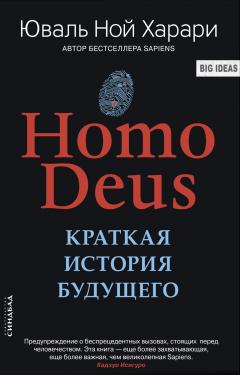Юваль Харари - Homo Deus. Краткая история будущего

Помощь проекту
Homo Deus. Краткая история будущего читать книгу онлайн
59
Фавелы – трущобы в городах Бразилии, часто расположенные на склонах гор.
60
Robert J. Lake, ‘Social Class, Etiquette and Behavioral Restraint in British Lawn Tennis’, International Journal of the History of Sport 28:6 (2011), 876–894; Beatriz Colomina, ‘Te Lawn at War: 1941–1961’, in Te American Lawn, ed. Georges Teyssot (New York: Princeton Architectural Press, 1999), 135–153; Virginia Scott Jenkins, Te Lawn: History of an American Obsession (Washington: Smithsonian Institution, 1994).
61
‘Canis lupus’, IUCN Red List of Threatened Species, accessed 20 December 2014, http://www.iucnredlist.org/details/3746/1; ‘Fact Sheet: Gray Wolf’, Defenders of Wildlife, accessed 20 December 2014, http://www.defenders.org/gray-wolf/basic-facts; ‘Companion Animals’, IFAH, accessed 20 December 2014, http://www.ifaheurope.org/companion-animals/about-pets.html; ‘Global Review 2013’, World Animal Protection, accessed 20 December 2014, https://www.worldanimalprotection.us.org/sites/default/fles/us_fles/global_review_2013_0.pdf.
62
Anthony D. Barnosky, ‘Megafauna Biomass Tradeof as a Driver of Quaternary and Future Extinctions’, PNAS 105:1 (2008), 11543–11548; for wolves and lions: William J. Ripple et al., ‘Status and Ecological Efects of the World’s Largest Carnivores’, Science 343:6167 (2014), 151; если верить доктору Стэнли Корену, сегодня на планете живет около 500 млн собак. См.: Stanley Coren, ‘How Many Dogs Are There in the World’, Psychology Today, 19 September 2012, accessed 20 December 2014, http://www.psychologytoday.com/blog/canine-corner/201209/how-many-dogs-are-there-in-the-world; о мировой популяции кошек см.: Nicholas Wade, ‘DNA Traces 5 Matriarchs of 600 Million Domestic Cats’, New York Times, 29 June 2007, accessed 20 December 2014, http://www.nytimes.com/2007/06/29/health/29iht-cats.1.6406020.html; подробнее об африканских буйволах см.: ‘Syncerus cafer’, IUCN Red List of Treatened Species, accessed 20 December 2014, http://www.iucnredlist.org/details/21251/0; подробнее о популяции крупного рогатого скота см.: David Cottle and Lewis Kahn, ed., Beef Cattle Production and Trade (Collingwood: Csiro, 2014), 66; подробнее о домашних курах см.: ‘Live Animals’, Food and Agriculture Organization of the United Nations: Statistical Division, accessed December 20, 2014, http://faostat3.fao.org/browse/Q/QA/E; подробнее о популяции шимпанзе см.: ‘Pan troglodytes’, IUCN Red List of Treatened Species, accessed 20 December 2014, http://www.iucnredlist.org/details/15933/0.
63
‘Living Planet Report 2014’, WWF Global, accessed 20 December 2014, http://wwf.panda.org/about_our_earth/all_publications/ living_planet_report/.
64
Richard Inger et al., ‘Common European Birds are Declining Rapidly While Less Abundant Species’ Numbers Are Rising’, Ecology Letters 18:1 (2014), 28–36; ‘Live Animals’, Food and Agriculture Organization of the United Nations, accessed 20 December 2014,http://faostat.fao.org/site/573/default.aspx#ancor.
65
Simon L. Lewis and Mark A. Maslin, ‘Defining the Anthropocene’, Nature 519 (2015), 171–180.
66
Timothy F. Flannery, Te Future Eaters: An Ecological History of the Australasian Lands and Peoples (Port Melbourne: Reed Books Australia, 1994); Anthony D. Barnosky et al., ‘Assessing the Causes of Late Pleistocene Extinctions on the Continents’, Science 306:5693 (2004), 70–75; Bary W. Brook and David M. J. S. Bowman, ‘Te Uncertain Blitzkrieg of Pleistocene Megafauna’, Journal of Biogeography 31:4 (2004), 517–523; Giford H. Miller et al., ‘Ecosystem Collapse in Pleistocene Australia and a Human Role in Megafaunal Extinction’, Science 309:5732 (2005), 287–290; Richard G. Roberts et al., ‘New Ages for the Last Australian Megafauna: Continent Wide Extinction about 46 000 Years Ago’, Science 292:5523 (2001), 1888–1892; Stephen Wroe and Judith Field, ‘A Review of Evidence for a Human Role in the Extinction of Australian Megafauna and an Alternative Explanation’, Quaternary Science Reviews 25:21–2 (2006), 2692–2703; Barry W. Brooks et al., ‘Would the Australian Megafauna Have Become Extinct If Humans Had Never Colonised the Continent? Comments on “A Review of the Evidence for a Human Role in the Extinction of Australian Megafauna and an Alternative Explanation” by S. Wroe and J. Field’, Quaternary Science Reviews 26:3–4 (2007), 560–564; Chris S. M. Turney et al., ‘Late-Surviving Megafauna in Tasmania, Australia, Implicate Human Involvement in their Extinction’, PNAS 105:34 (2008), 12150–12153; John Alroy, ‘A Multispecies Overkill Simulation of the End-Pleistocene Megafaunal Mass Extinction’, Science 292:5523 (2001), 1893–1896; J. F. O’Connel and J. Allen, ‘Pre-LGM Sahul (Australia-New Guinea) and the Archaeology of Early Modern Humans’, in Rethinking the Human Evolution: New Behavioral and Biological Perspectives on the Origin and Dispersal of Modern Humans, ed. Paul Mellars (Cambridge: McDonald Institute for Archaeological Research, 2007), 400–401.
67
Graham Harvey, Animism: Respecting the Living World (Kent Town: Wakefeld Press, 2005); Rane Willerslev, Soul Hunters: Hunting, Animism and Personhood Among the Siberian Yukaghirs (Berkeley: University of California Press, 2007); Elina Helander-Renvall, ‘Animism, Personhood and the Nature of Reality: Sami Perspectives’, Polar Record 46:1 (2010), 44– 56; Istvan Praet, ‘Animal Conceptions in Animism and Conservation’, in Routledge Handbook of Human-Animal Studies, ed. Susan McHaugh and Garry Marvin (New York: Routledge, 2014), 154–167; Nurit Bird-David, ‘Animism Revisited: Personhood, Environment, and Relational Epistemology’, Current Anthropology 40 (1999): s67–91; N. Bird-David, ‘Animistic Epistemology: Why Some Hunter-Gatherers Do Not Depict Animals’, Ethnos 71:1 (2006): 33–50.
68
Быт., 3: 19.
69
Howard N. Wallace, ‘Te Eden Narrative’, Harvard Semitic Monographs 32 (1985), 147–181.
70
David Adams Leeming and Margaret Adams Leeming, Encyclopedia of Creation Myths (Santa Barbara: ABC–CLIO, 1994), 18; Sam D. Gill, Storytracking: Texts, Stories, and Histories in Central Australia (Oxford: Oxford University Press, 1998); Emily Miller Bonney, ‘Disarming the Snake Goddess: A Reconsideration of the Faience Figures from the Temple Repositories at Knossos’, Journal of Mediterranean Archaeology 24:2 (2011), 171–190; David Leeming, Te Oxford Companion to World Mythology (Oxford and New York: Oxford University Press, 2005), 350.
71
Согласно теории американского нейрофизиолога Пола Маклина, человеческий мозг состоит из трех частей, насаженных одна на другую по принципу матрешки. Центральная часть – это так называемый древний мозг, мозг рептилий.
72
Давление отбора – показатель интенсивности действия естественного отбора. Зависит от внешних факторов среды, межвидовой и внутривидовой конкуренции.
73
Jerome H. Barkow, Leda Cosmides and John Tooby, ed., Te Adapted Mind: Evolutionary Psychology and the Generation of Culture (Oxford: Oxford University Press, 1992); Richard W. Bloom and Nancy Dess, ed., Evolutionary Psychology and Violence: A Primer for Policymakers and Public Policy Advocates (Westport: Praeger, 2003); Charles Crawford and Catherine Salmon, ed., Evolutionary Psychology, Public Policy and Personal Decisions (New Jersey: Lawrence Erlbaum Associates, 2008); Patrick McNamara and David Trumbull, An Evolutionary Psychology of Leader – Follower Relations (New York: Nova Science, 2007); Joseph P. Forgas, Martie G. Haselton and William von Hippel, ed., Evolution and the Social Mind: Evolutionary Psychology and Social Cognition (New York: Psychology Press, 2011).
74
S. Held, M. Mendl, C. Devereux and R. W. Byrne, ‘Social tactics of pigs in a competitive foraging the task: the “informed forager” paradigm’, Animal Behaviour 59:3 (2000), 569–576; S. Held, M. Mendl, C. Devereux and R. W. Byrne, ‘Studies in social cognition: from primates to pigs’, Animal Welfare 10 (2001), s209–217; H. B. Graves, ‘Behavior and ecology of wild and feral swine (Sus scrofa)’, Journal of Animal Science 58:2 (1984), 482–492; A. Stolba and D. G. M. Wood-Gush, ‘Te behaviour of pigs in a semi-natural environment’, Animal Production 48:2 (1989), 419–425; M. Spinka, ‘Behaviour in pigs’, in P. Jensen (ed.), Te Ethology of Domestic Animals, 2nd edition (Wallingford, UK: CAB International, 2009), 177–191; P. Jensen and D. G. M. Wood-Gush, ‘Social interactions in a group of free-ranging sows’, Applied Animal Behaviour Science 12 (1984), 327–337; E. T. Gieling, R. E. Nordquist and F. J. van der Staay, ‘Assessing learning and memory in pigs’, Animal Cognition 14 (2011), 151–173.
75
I. Horrell and J. Hodgson, ‘Te bases of sow-piglet identifcation. 2. Cues used by piglets to identify their dam and home pen’, Applied Animal Behavior Science, 33 (1992), 329–343; D. M. Weary and D. Fraser, ‘Calling by domestic piglets: Reliable signals of need?’, Animal Behaviour 50:4 (1995), 1047–1055; H. H. Kristensen et al., ‘Te use of olfactory and other cues for social recognition by juvenile pigs’, Applied Animal Behaviour Science 72 (2001), 321–333.
76
M. Helf, ‘Pig video arcades critique life in the pen’, Wired, 6 June 1997, http://archive.wired.com/science/discoveries/news/1997/06/4302 retrieved 27 January 2016.
77
Humane Society of the United States, ‘A n HSUS Report: Welfare Issues with Gestation Crates for Pregnant Sows’, February 2013, http://www.humanesociety.org/assets/pdfs/farm/HSUS-Report-on-Gestation-Crates-for-Pregnant-Sows.pdf, retrieved 27 January 2016.
78
Turnbull and Solms, Brain and the Inner World, 90–92.
79
David Harel, Algorithmics: Te Spirit of Computers, 3rd edn [in Hebrew] (Tel Aviv: Open University of Israel, 2001), 4–6; David Berlinski, Te Advent of the Algorithm: Te 300-Year Journey from an Idea to the Computer (San Diego: Harcourt, 2000); Hartley Rogers Jr, Teory of Recursive Functions and Efective Computability, 3rd edn (Cambridge, MA and London: MIT Press, 1992), 1–5; Andreas Blass and Yuri Gurevich, ‘Algorithms: A Quest for Absolute Defnitions’, Bulletin of European Association for Teoretical Computer Science 81 (2003), 195–225; Donald E. Knuth, Te Art of Computer Programming, 2nd edn (New Jersey: Addison-Wesley Publishing Company, 1973).
80
Daniel Kahneman, Tinking, Fast and Slow (New York: Farrar, Straus & Giroux, 2011); Dan Ariely, Predictably Irrational (New York: Harper, 2009).
81
Justin Gregg, Are Dolphins Really Smart? The Mammal Behind the Myth (Oxford: Oxford University Press, 2013), 81–87; Jaak Panksepp, ‘Afective Consciousness: Core Emotional Feelings in Animals and Humans’, Consciousness and Cognition 14:1 (2005), 30–80.
82
A. S. Fleming, D. H. O’Day and G. W. Kraemer, ‘Neurobiology of Mother – Infant Interactions: Experience and Central Nervous System Plasticity Across Development and Generations’, Neuroscience and Biobehavioral Reviews 23:5 (1999), 673–685; K. D. Broad, J. P. Curley and E. B. Keverne, ‘Mother – Infant Bonding and the Evolution of Mammalian Relationship’, Philosophical Transactions of the Royal Society B 361:1476 (2006), 2199–2214; Kazutaka Mogi, Miho Nagasawa and Takefumi Kikusui, ‘Developmental Consequences and Biological Signifcance of Mother-Infant Bonding’, Progress in Neuro-Psychopharmacology and Biological Psychiatry 35:5 (2011), 1232–1241; Shota Okabe et al., ‘Te Importance of Mother– Infant Communication for Social Bond Formation in Mammals’, Animal Science Journal 83:6 (2012), 446–452.
83
Бихевиоризм (от англ. behavior – поведение) – одна из самых распространенных теорий в западной психологии первой половины XX века. Ее основатель – американский психолог Джон Бродес Уотсон (1878–1958).
84
Jean O’Malley Halley, Boundaries of Touch: Parenting and Adult– Child Intimacy (Urbana: University of Illinois Press, 2007), 50–51; Ann Taylor Allen, Feminism and Motherhood in Western Europe, 1890–1970: Te Maternal Dilemma (New York: Palgrave Macmillan, 2005), 190.
85
Lucille C. Birnbaum, ‘Behaviorism in the 1920s’, American Quarterly 7:1 (1955), 18.
86
US Department of Labor (1929), ‘Infant Care’, Washington: United States Government Printing Ofce, http://www.mchlibrary.info/history/chbu/3121–1929.PDF.
87
Harry Harlow and Robert Zimmermann, ‘Afectional Responses in the Infant Monkey’, Science 130:3373 (1959), 421–432; Harry Harlow, ‘Te Nature of Love’, American Psychologist 13 (1958), 673–685; Laurens D. Young et al., ‘Early Stress and Later Response to Sepаration in Rhesus Monkeys’, American Journal of Psychiatry 130:4 (1973), 400–405; K. D. Broad, J. P. Curley and E. B. Keverne, ‘Mother – Infant Bonding and the Evolution of Mammalian Social Relationships’, Philosophical Transactions of the Royal Soceity B 361:1476(2006), 2199–2214; Florent Pittet et al., ‘Efects of Maternal Experience on Fearfulness and Maternal Behavior in a Precocial Bird’, Animal Behavior 85:4(2013), 797–805.
























